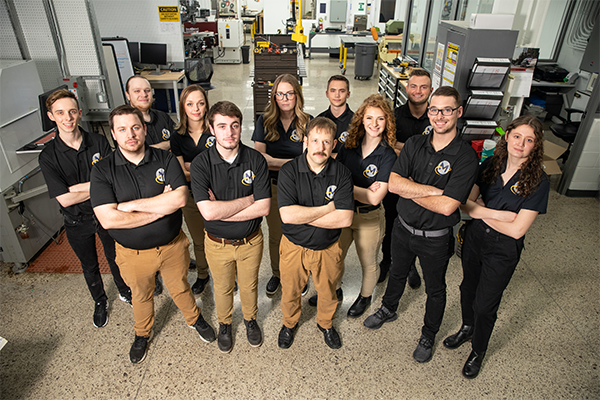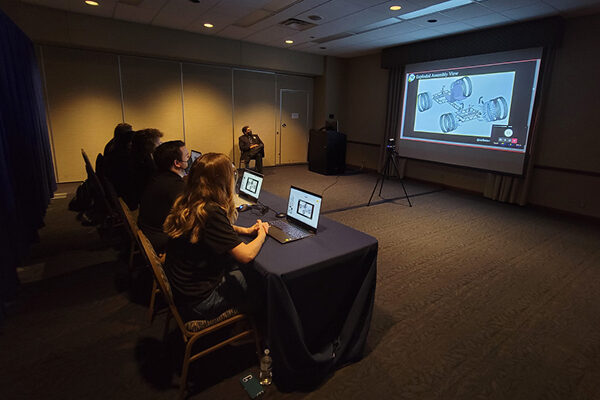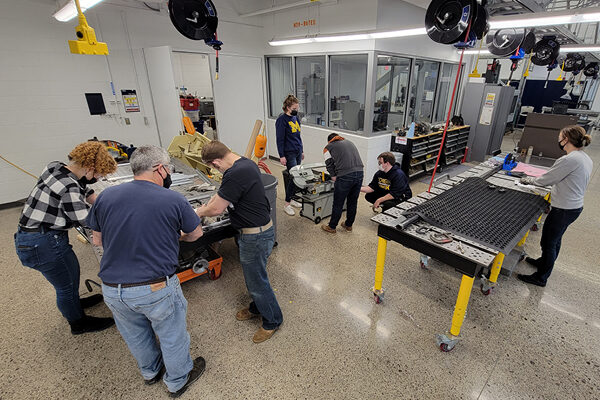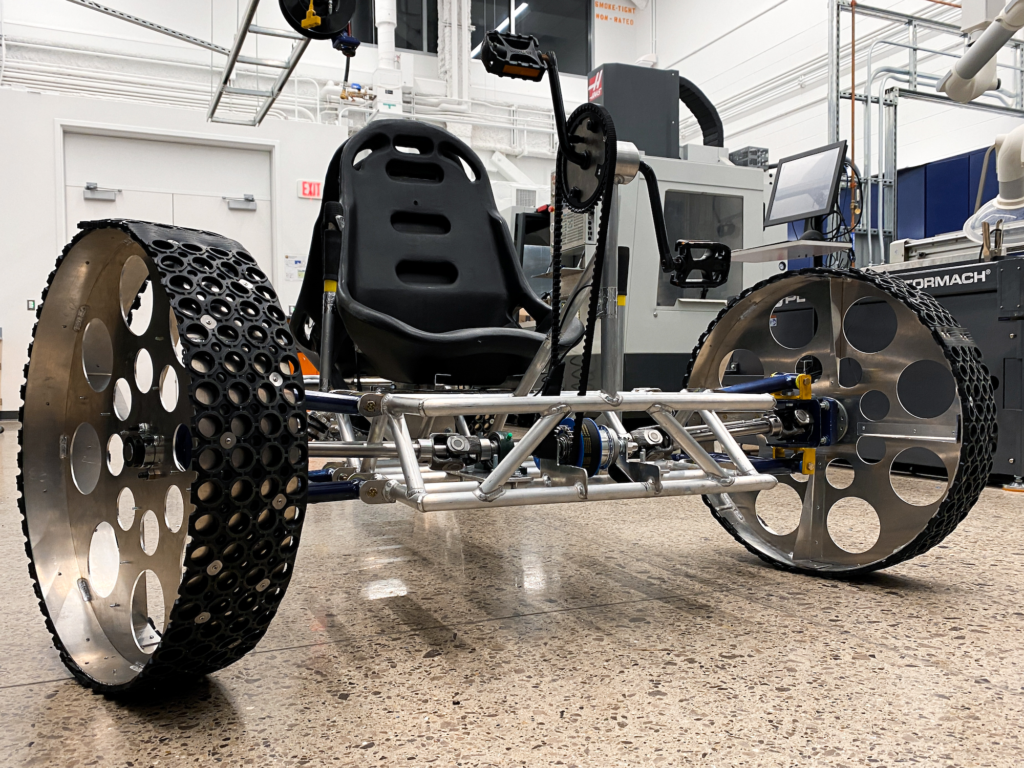
The UM-Flint NASA HERC team members include (Left to Right): Logan Minuado, Jeffrey Reid, Cameron Hall, Bethany Priest, Evan Rudziensky, Erin Stiers, Paul Beiswenger, Robert Jackson, Samantha Hunsinger, Austin Graham, Jacob Moore, and Genevieve Heydt.
You’ve probably heard the phrase “teamwork makes the dream work.” But what happens when three cross-dimensional teams from UM-Flint Engineering, Computer Science, and Mathematics work together? That dream gets even bigger. Starting in the Fall 2021 semester, students formed the UM-Flint NASA HERC Team to compete in NASA’s Human Exploration Rover Challenge (HERC). The HERC Challenge is an annual event where students worldwide compete using human-powered vehicles, also known as rovers, that they design and build.
Forming the team
The team first came together at the start of the Fall 2021 semester when team captain Samantha Hunsinger discovered the NASA HERC competition while searching for aerospace and NASA-related projects for her capstone project.
“I came into work the next day in the ITS Helpdesk, and excitedly told my co-worker, Jake [Jacob Moore, computer science team captain], about the competition,” Hunsinger said. “Together, we then hatched the idea of a collaborative/cross-functional capstone project where my team could build the rover, and his team could build the website and do telemetry. It was a joke at first, and then it got more serious as we wanted to see if it could actually happen.”
From there, Hunsinger and Moore established a team. They got started with the approval process, including getting buy-in from professors and department chairs, finding a faculty advisor, and organizing all aspects of the project, from funding to shipping and travel for the competition. Once the groundwork had been laid, the team could begin research and design for the rover and its systems using a set of competition details and design requirements. Between the teams, they not only had to design a drivable rover that could stand up to unforgiving terrain, but also hardware and software that would allow them to perform additional tasks. Lastly, the team had to come up with a strategy for competition. Genevieve Heydt, data analytics major and computer science minor, wrote a computer program to estimate and calculate the best course of action for the excursion. This program allowed the team to determine what obstacles and tasks would allow them to collect the most points.

Presenting to NASA Engineers
The team’s hard work was on display in their December design review presentation, during which they presented their initial rover design to engineers from NASA. During the presentation, team members dove into detail on all aspects of the rover design, from the type of materials used, to mechanisms like the drivetrain, steering, and a hinge system allowing the rover to fold for transport. Members gave reasoning behind design choices and showed how they reached conclusions, referencing metrics like stress tests. NASA engineers were able to ask questions about design choices, identify possible trouble areas, and give feedback on areas that the team could consider readdressing.
Faculty advisor Rajib Ganguly, associate professor of physics, recognizes that working with NASA engineers is a unique opportunity for undergraduate students.
“The competition itself is a great way to motivate engineering projects and to stimulate the creativity of our future engineers, but even more valuable is the interactions that the students get with engineers that actually work for NASA,” Ganguly said. “The students have to do reviews of their designs and work through telecoms, and they get fantastic feedback from those engineers.”
Capstone projects at UM-Flint are meant to encompass the entirety of the knowledge and skills students gain throughout their time at the university and be representative of the work in their future fields. The UM-Flint NASA HERC team stands out with its cross-dimensional nature and high skill level.
Ganguly says that the format of the project can inspire future capstone projects at UM-Flint.
“Nearly every aspect of this competition is a skill developed that students will use in the future,” Ganguly said. “Considering a problem and assembling a team with varied expertise to tackle it, delegating different aspects of the project to different subsets of the team, coming up with possible ideas and working through which ones work, which ones don’t, and which is the best at accomplishing the goal, and identifying and developing skills during the implementation–these are all things that are generally applicable to succeeding in life”.

Building the Rover
Coming back for the winter semester, the team set to work implementing suggestions provided by NASA’s engineers, ordered materials, and began planning for the build process. In early February, the real fun began as members met up in the Murchie Science Building machine shop to begin fabrication, starting by bending and assembling the rover’s wheels by hand, and cutting and laying frame tubing to be welded.
Hunsinger credits the state-of-the-art resources in the Murchie Science Building as a key for the team.
“The resources in the new Murchie Science Building expansion have been a huge advantage. Being able to work on this project using all of the tools in the machine shop has been awesome,” Hunsinger said.

Getting ready for take-off
Since then, the team has nearly completed their rover, most recently installing the software team’s wiring harness, and are now just applying the finishing touches. Last week the team had their Operational Readiness Review with NASA to show that the rover was fully functional. Currently, the team is building an obstacle course to test the rover and has also been taking full advantage of the condition of our Michigan roads this spring, using the moonlike surface for further testing.
The group will compete in the final event in its virtual format by creating their own obstacle courses and video presentation for NASA to review. In this final test of the rover, the team will work to complete tasks mimicking operations that take place on real NASA missions, such as spectrographic analysis, instrument deployment, and various sample retrievals.
From in-depth planning, extensive research, and lots of teamwork, the UM-Flint NASA HERC team is proof that students can take their skills to a national level.
To keep up with the team, check out the team’s website, www.umflintrover.com and @umflintrover on social media.


